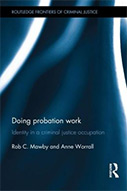Doing Probation Work: Identity in a Criminal Justice Occupation
 Author: Rob C. Mawby and Anne Worrall
Author: Rob C. Mawby and Anne Worrall
Publisher: Abingdon, UK; New York: Routledge, 2013. 200 p.
Reviewer: Maurice Vanstone | September 2013
From the moment when, as a trainee carrying my bag of goodwill, I stood outside a flat in the East End of London one evening in 1969 waiting in vain for someone to open the door after I had replied enthusiastically ‘the probation officer,’ to ‘who’s that’ from a voice behind the closed door, I knew that I was qualifying for a difficult job! This book throws light on why people take on such work, give meaning to it in practice, and respond to its increasingly complex demands. It is an absorbing read in its own right, but added piquancy accrued from the interaction between my memories and experiences and the probation workers’ stories contained within its pages, as far as it stimulated a fascinating parallel narrative. As with all stories, mine has been reshaped, modified, and given fresh interpretations and reflections in the retelling. Maybe from that derived the pleasure of reviewing this book, although to say that implies a lack of sufficient respect for its overall quality and erudition.
When I saw the names of the authors of this book I expected it to be insightful, thought provoking and shrewdly analytical. I was not disappointed. They explore the culture of the probation service through the stories of sixty current and former probation workers whom they categorise as (with well judged irony) lifers (those like myself who joined the service at a young age), second careerists, and offender managers (recent recruits). Their stories are set against the now familiar background of politicisation, media and public criticism, increased accountability, and risk realism. The exploration covers what probation workers do, their changing relationships with courts, police and prisons, how they see themselves being viewed, how they respond to ‘turbulent times,’ and how a variety of cultures have been crafted by an increasingly diverse workforce.
Surprisingly, as it is a book about probation at the beginning of the 21st century, it is in essence optimistic. Stereotypes – lifers idealistic and motivated by vocation; second careerists, realists with a hard edge honed in other occupations; offender managers, automatons glued to the computer screen and risk assessment tick-box tools – are confounded. Admittedly, some aspects of the job have changed fundamentally – computers and desk work are dominant, the physical environment is more likely to be open plan and anonymous, and home visits have declined; and latterly the job has become tainted (although it can be argued that it was always ‘dirty work’). The benign political and social climate has been replaced by the harsher critical scrutiny of politicians, media and public alike, and the extra pressure that comes with it. Yet despite all these changes and the fact that the three groups of workers have different characteristics, they respond in ways that provide optimism for the future: they shape their careers positively, they develop effective coping strategies, and do the job in ways that enhances the positivity of difficult face-to-face encounters. Moreover, a sense of vocation survives among many and they share a belief in the possibilities of change and the ‘worthwhileness’ of the work, faith (sometimes religious) in people, a recognition of the importance of public protection, risk assessment, risk management and the rights of victims, and a resoluteness about effectiveness. The probation workers represented in this book share a desire to put their professional skills to the test for the collective good of those they supervise, victims, the public, and the organization (what the authors term ‘responsible creativity’); and to undertake their work as multi-specialists in cooperation with all relevant agencies. In its entirety, the research produces a picture of a group of workers who are uniquely expert in the management and supervision of people who present a high risk of reoffending.
The probation service may not survive, but Mawby and Worral provide reasons to believe that if it is abolished, at some point in the future it would need to be re-invented. Probation is important, pragmatic humanistic work and, therefore, as they put it ‘someone has to do it.’ Over and above the realistic vision of the job that emerges from the stories so entertainingly presented, the book provides an exemplar for the use of qualitative methods in research and the analysis of organisational cultures. Read in conjunction with the recent work of Deering and Fitzgibbon1, this excellent book provides the fullest account of contemporary probation practice currently available.
Reference
1 Deering, J. (2010) Probation Practice and the New Penology. Practitioner Reflections. Farnham: Ashgate; Fitzgibbon, W. (2011) Probation and Social Work on Trial. Basingstoke: Palgrave Macmillan.
Maurice Vanstone, Emeritus Professor of Criminology and Criminal Justice, Swansea University


